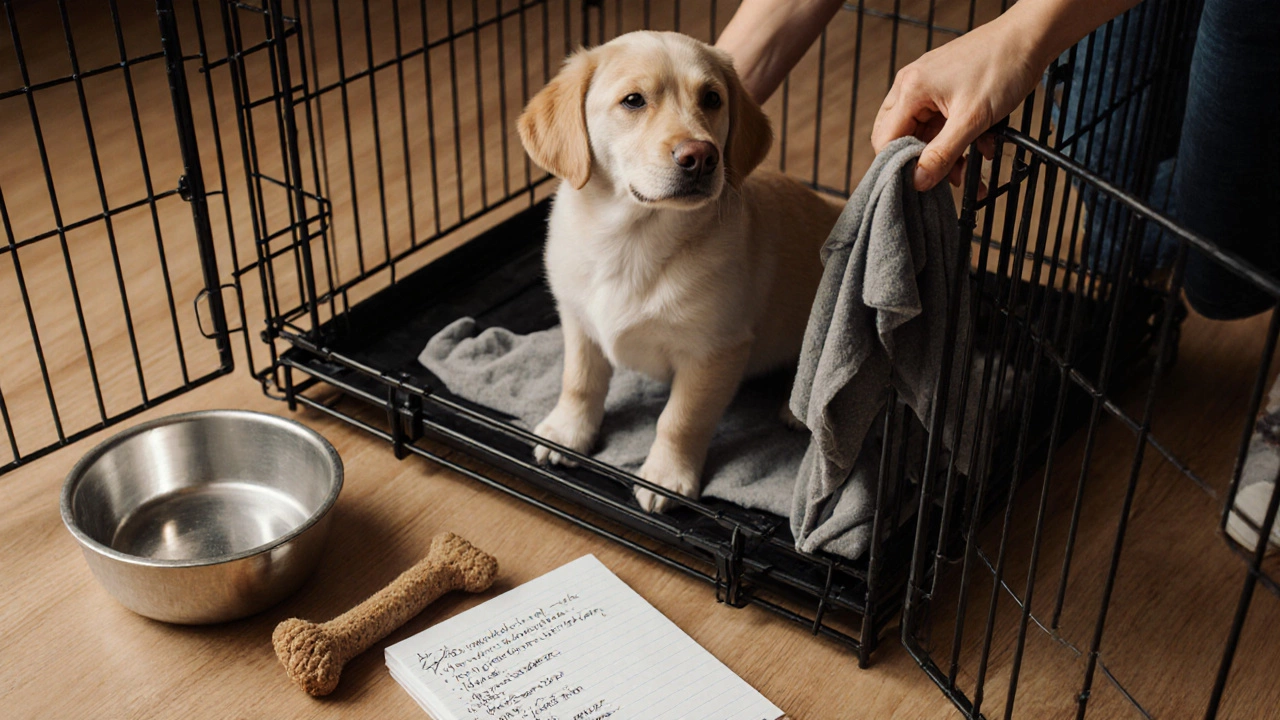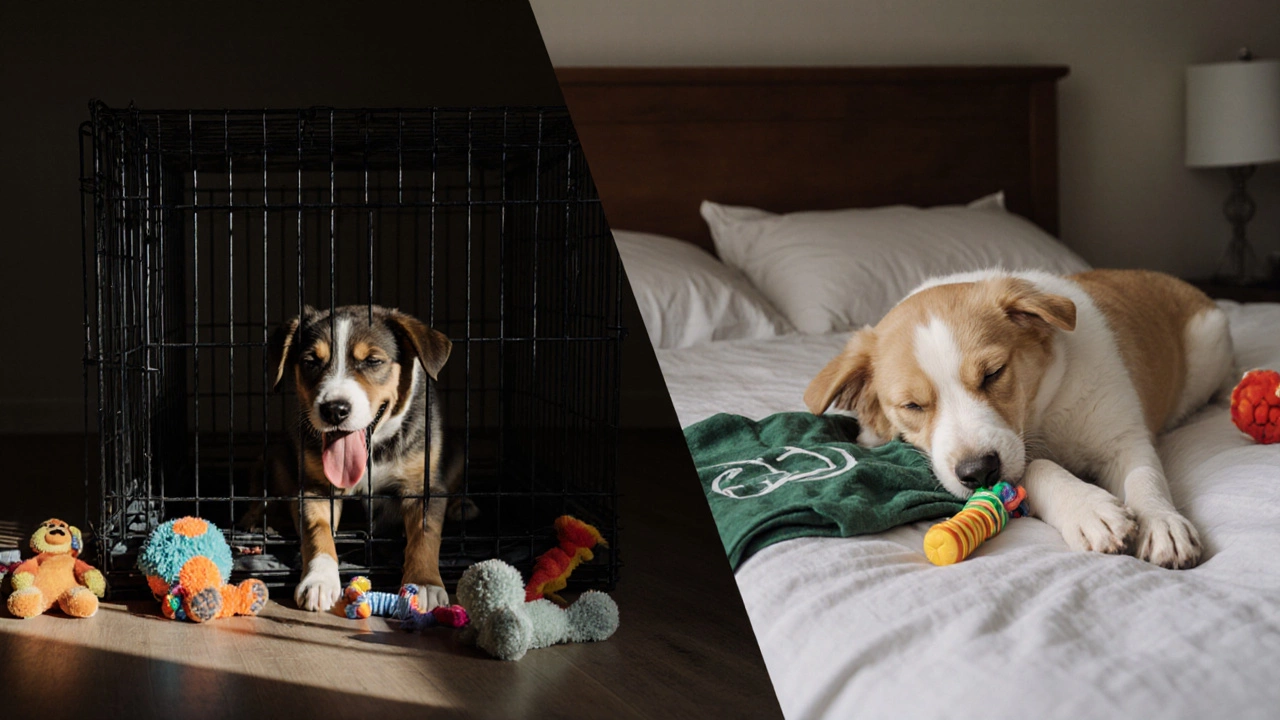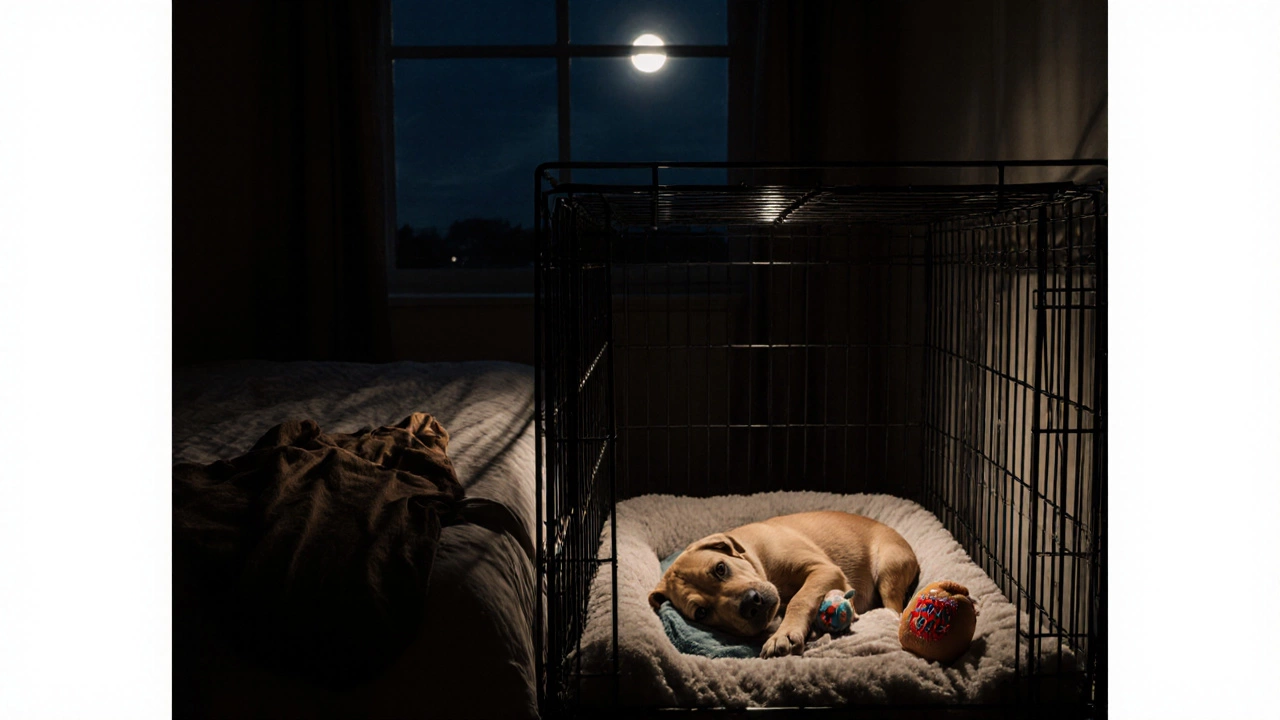Puppy Crate Time Calculator
Calculate Safe Crate Time
Follow the one-hour-per-month rule and behavior guidelines from the article.
Enter your puppy's age and behavior to see recommended crate time
Crate Time Guidelines
One hour per month of age, up to 8 hours:
- 8 weeks → max 2-3 hours
- 12 weeks → 3-4 hours
- 16 weeks → 4-5 hours
- 6 months → 6-7 hours
- Over 6 months → 8 hours (if trained)
He sleeps through the night without crying for 2 weeks straight
He hasn't had an accident in the house for 30 days
He goes to the crate on his own when it's time to sleep
He doesn't chew on furniture or shoes when unsupervised
Is your puppy howling at 2 a.m. because you locked him in his crate? You’re not alone. Thousands of new puppy owners ask this same question every night: Should I lock my puppy in his crate at night? The answer isn’t yes or no-it’s about timing, trust, and how you set it up.
Why Crates Work for Puppies
Puppies are den animals. In the wild, they’d sleep curled up in a tight, safe space. A crate mimics that instinct. When used right, it gives your puppy a quiet place to rest, helps with house training, and prevents accidents or chewing when you’re asleep.But locking a puppy in a crate isn’t about punishment. It’s about structure. A 10-week-old puppy can’t hold it for 8 hours. A 6-month-old might. The key isn’t forcing silence-it’s building confidence.
When It’s a Good Idea to Crate at Night
- Your puppy is under 6 months old and still learning bladder control
- You’ve had accidents on the floor more than twice this week
- You’re not home during the day and need to keep your puppy safe
- Your puppy gets anxious when left alone and calms down in the crate
These are signs your puppy needs the structure a crate provides. But only if the crate feels like a safe space-not a jail.
When It’s a Bad Idea
- Your puppy whimpers or cries for more than 20 minutes every night
- You’ve never trained him to like the crate-he associates it with being left alone
- You’re using the crate because you’re tired of cleaning up messes, not because you’re teaching
- Your puppy is panting, drooling, or trying to chew through the bars
If your puppy is stressed, locking him in won’t fix the problem. It’ll make it worse. That crying? It’s not manipulation. It’s fear.
How to Make the Crate Feel Like Home
Start by leaving the crate door open during the day. Put a soft bed inside. Toss in a chew toy that smells like you-something worn, not new. Feed meals near the crate, then inside it. Let him explore it on his own.After a week, try closing the door for 5 minutes while you’re home. Gradually increase the time. If he’s calm, reward him with a treat. If he panics, open the door. Don’t rush this.
At night, place the crate in your bedroom. Puppies are social animals. Hearing your breathing, knowing you’re nearby, cuts down on anxiety. A crate in the garage or another room is a recipe for sleepless nights-for you and your pup.

What to Put Inside the Crate at Night
- A washable, snug bed (no fluffy blankets-they can be chewed and swallowed)
- A safe chew toy (a Kong stuffed with frozen peanut butter works great)
- A piece of your old T-shirt (smells like you, calms him)
Avoid plush toys with stuffing, squeakers, or small parts. Puppies can tear them apart and choke. A frozen carrot or a lick mat with yogurt is a better option than a toy that falls apart.
How Long Can a Puppy Stay in a Crate at Night?
There’s a simple rule: One hour per month of age, up to 8 hours.- 8 weeks old → max 2-3 hours
- 12 weeks old → 3-4 hours
- 16 weeks old → 4-5 hours
- 6 months old → 6-7 hours
- Over 6 months → 8 hours is okay if he’s healthy and trained
That doesn’t mean you should lock him in for the full time right away. Build up slowly. If your 10-week-old puppy is howling at 1 a.m., he’s not being stubborn-he’s got a full bladder. Take him out. Praise him quietly. Put him back. Don’t turn it into a game.
What to Do If He Cries
Crying is normal at first. But if it lasts longer than 20 minutes, something’s wrong.- Check if he needs to go out
- Make sure the crate isn’t too cold or too hot
- Is he hungry? Did he eat too late?
- Is the crate too big? A puppy should be able to stand, turn, and lie down-no extra space
If none of those apply, wait 5 minutes. Then go in quietly, say “good boy,” and leave. Don’t pick him up, don’t play, don’t comfort him like he’s hurt. That teaches him crying gets attention.
Consistency is everything. If you give in one night, he’ll cry harder the next. If you stay calm, he’ll learn the crate is safe.

Signs Your Puppy Is Ready to Sleep Outside the Crate
- He sleeps through the night without crying for 2 weeks straight
- He hasn’t had an accident in the house for 30 days
- He goes to the crate on his own when it’s time to sleep
- He doesn’t chew on furniture or shoes when unsupervised
When those happen, try leaving the crate door open. Let him choose. If he curls up inside, great. If he sleeps on the floor next to your bed, that’s fine too. The goal isn’t to force the crate forever-it’s to teach him self-control.
Common Mistakes New Owners Make
- Using the crate as punishment-never put him in for bad behavior
- Buying a crate that’s too big-he’ll use one end as a bathroom
- Leaving him in too long without a potty break
- Ignoring early signs of stress (panting, pacing, drooling)
- Thinking he’ll “outgrow” crate anxiety-it won’t fix itself without training
One owner I know in Dublin tried crating her 12-week-old puppy for 8 hours straight. He chewed through the latch, broke a tooth, and ended up at the vet. That’s not discipline. That’s neglect.
Final Thought: It’s Not About Control
Locking your puppy in his crate at night isn’t about making your life easier. It’s about giving him the safety he needs to grow up calm and confident. If he’s scared, he’ll never learn to trust. If you rush it, he’ll learn to fear the crate-and that’s harder to fix than accidents on the carpet.Take your time. Watch his body language. Adjust as he grows. And remember-this isn’t a test of your patience. It’s a lesson in empathy.
Is it cruel to crate a puppy at night?
No, if done correctly. A crate becomes a safe, comforting space when introduced slowly and with positive experiences. It’s only cruel if used as punishment, left too long, or if the puppy is scared and left to cry without help.
How long should a puppy stay in a crate at night?
Follow the one-hour-per-month rule: a 3-month-old puppy can handle 3-4 hours, a 6-month-old can do 6-7 hours, and an adult dog can sleep 8 hours. Always take young puppies out for a potty break if they cry after their limit.
Should I leave water in the crate at night?
No, for puppies under 6 months. Water increases the need to pee, which leads to accidents and sleepless nights. Offer water right before bed, then remove it 1-2 hours before bedtime. After 6 months, a spill-proof bowl is fine if he’s trained.
What if my puppy chews the crate?
If your puppy is chewing the crate, it’s likely because he’s anxious or the crate is too big. Switch to a smaller size if needed, and make sure he has safe chew toys inside. If chewing continues, talk to a certified trainer-this isn’t normal behavior.
Can I use a dog bed instead of a crate at night?
Only if your puppy is fully house-trained, doesn’t chew things, and sleeps quietly. Most puppies under 6 months aren’t ready. A crate gives structure and prevents accidents. Once he’s reliable, you can slowly transition to a bed.
Next Steps for New Puppy Owners
- Start crate training today-even 5 minutes at a time
- Place the crate in your bedroom for the first 2 weeks
- Use a Kong with frozen peanut butter as a bedtime treat
- Track accidents and crying in a notebook-patterns reveal progress
- Don’t give up after a bad night. Consistency beats perfection
Your puppy isn’t trying to break your will. He’s trying to survive a new world. The crate is your tool to help him feel safe. Use it wisely.

